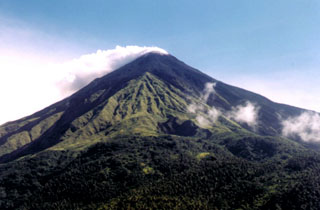Report on Karangetang (Indonesia) — July 1997
Bulletin of the Global Volcanism Network, vol. 22, no. 7 (July 1997)
Managing Editor: Richard Wunderman.
Karangetang (Indonesia) Three people killed by a pyroclastic flow in June
Please cite this report as:
Global Volcanism Program, 1997. Report on Karangetang (Indonesia) (Wunderman, R., ed.). Bulletin of the Global Volcanism Network, 22:7. Smithsonian Institution. https://doi.org/10.5479/si.GVP.BGVN199707-267020
Karangetang
Indonesia
2.781°N, 125.407°E; summit elev. 1797 m
All times are local (unless otherwise noted)
On 17 April the Bureau of Meteorology in Darwin received a report from the Volcanological Survey of Indonesia of an ongoing eruption at Karangetang; however, the plume height could not be observed because of cloud cover, and no plume was seen in later satellite imagery. The Societe de Volcanologie de Geneve (SVG) reported that explosions and pyroclastic flows in June required the evacuation of 400 people from a village. They further reported that this eruptive episode claimed the lives of three people. The last reported activity consisted of daily ash explosions during October 1996.
Geological Summary. Karangetang (Api Siau) volcano lies at the northern end of the island of Siau, about 125 km NNE of the NE-most point of Sulawesi. The stratovolcano contains five summit craters along a N-S line. It is one of Indonesia's most active volcanoes, with more than 40 eruptions recorded since 1675 and many additional small eruptions that were not documented (Neumann van Padang, 1951). Twentieth-century eruptions have included frequent explosive activity sometimes accompanied by pyroclastic flows and lahars. Lava dome growth has occurred in the summit craters; collapse of lava flow fronts have produced pyroclastic flows.
Information Contacts: Bureau of Meteorology, Northern Territory Regional Office, P.O. Box 735, Darwin NT, Australia; Societe de Volcanologie Geneve (SVG), B.P. 298, CH-1225, Chenebourg, Switzerland.

